Perspectives on Early Amazonian Agriculture from Guyana and Venezuela
Abstract
1. Introduction: Counterfeit Paradise or Garden Cities?
2. Habitats, Subsistence, and Agriculture in the Amazon
- Resource structure and distribution varied strongly according to properties of local habitats such as the várzea and terra firme.
- Sedentism, storage, and ceramics in the várzea pre-date agriculture and were supported by intensive reliance on aquatic foods.
- Maize was introduced early but took centuries to become a staple and mostly in várzea habitats.
- Aquatic prey and foraged terrestrial foods retained importance alongside agriculture including intensive maize farming in the lowlands.
- Wild foods and mobility in the terra firme retained high adaptive value after agriculture.
- Human activities fundamentally altered ecosystems and therefore adaptive options for human populations.
3. An Archaeological Case Study in Agriculture from Guyana
3.1. Climate, Environment, Settlement, and Subsistence
3.2. Archaeology and Ethnography of Northeastern Guyana
3.3. Habitation Mounds and Raised Fields
3.4. The Archaeology of Dubulay
3.5. Costs and Productivity of Agricultural Field Construction
4. Ethnoarchaeological Frames of Reference for Foraging, Fishing, and Cultivation: The Pumé of Venezuela
4.1. Climate, Environment, Settlement, and Subsistence
4.2. Lessons from Pumé Subsistence: The Wet Season
4.3. Lessons from Pumé Subsistence: The Dry Season
5. Summary and Implications
Author Contributions
Funding
Data Availability Statement
Acknowledgments
Conflicts of Interest
References
- Gross, D.R. Village movement in relation to resources in Amazonia. In Adaptive Responses of Native Amazonians; Hames, R., Vickers, W., Eds.; Academic Press: New York, NY, USA, 1983; pp. 429–449. [Google Scholar]
- Gross, D.R. Protein capture and cultural development in the Amazon Basin. Am. Anthropol. 1975, 77, 526–549. [Google Scholar] [CrossRef]
- Johnson, A. Reductionism in cultural ecology: The Amazon case. Curr. Anthropol. 1982, 23, 413–428. [Google Scholar] [CrossRef]
- Meggers, B.J. Possible Impact of the Mega-Niño Events on Precolumbian Populations in the Caribbean Area. In Ponencias, Primer Seminario de Arqueologia del Caribe; Maggiolo, M.V., Fuentes, A.C., Eds.; Museo Arqueologico Regional Altas de Chavon, Organización de los Estados Americanos: Altas De Chavon, Dominican Republic, 1996; pp. 156–176. [Google Scholar]
- Meggers, B.J. Amazonia: Man, and Culture in a Counterfeit Paradise; Smithsonian Institution Press: Washington, DC, USA, 1984. [Google Scholar]
- Meggers, B.J. Archaeological and Ethnographic Evidence Compatible with the Model of Forest Fragmentation. In Biological Diversification in the Tropics; Prance, G.T., Ed.; Columbia University Press: New York, NY, USA, 1982; pp. 483–496. [Google Scholar]
- Meggers, B.J. Environmental limitation on the development of culture. Am. Anthropol. 1954, 56, 801–824. [Google Scholar] [CrossRef]
- Ross, E.B. Food Taboos, Diet and Hunting Strategy: The Adaptation to Animals in Amazon Cultural Ecology. Curr. Anthropol. 1978, 19, 1–36. [Google Scholar] [CrossRef]
- Sponsel, L.E. Farming and foraging: A necessary complementarity in Amazonia? In Farmers as Hunters: The Implications of Sedentism; Kent, S., Ed.; University of Cambridge Press: Cambridge, UK, 1989; pp. 37–45. [Google Scholar]
- Neves, E.G. El Formativo que nunca terminó: La larga historia de estabilidad en las ocupaciones humanas de la Amazonía central. Boletín Arqueol. PUCP 2007, 11, 117–142. [Google Scholar] [CrossRef]
- Roosevelt, A.C. Method and Theory of Early Farming: The Orinoco and Caribbean Coasts of South America. Earth Sci. Res. 2017, 6, 1. [Google Scholar] [CrossRef]
- Denevan, W.M. (Ed.) The Native Population of the Americas in 1492; University of Wisconsin Press: Madison WI, USA, 1992. [Google Scholar]
- Viveiros de Castro, E. Images of Nature and Society in Amazonian Ethnology. Ann. Rev. Anthropol. 1996, 25, 179–200. [Google Scholar] [CrossRef]
- Willey, G.R. An Introduction to American Archaeology, South America; Prentice-Hall: Englewood Cliffs, NJ, USA, 1966; Volume 2. [Google Scholar]
- Arroyo-Kalin, M. The Amazonian Formative: Crop domestication and anthropogenic soils. Diversity 2010, 2, 473–504. [Google Scholar] [CrossRef]
- Baleé, W.L. Cultural Forests of the Amazon: A Historical Ecology of People and Their Landscapes; University of Alabama Press: Tuscaloosa, AL, USA, 2013. [Google Scholar]
- da Costa, M.L.; Kern, D.C. Geochemical signatures of tropical soils with archaeological black earth in the Amazon, Brazil. J. Geochem. Explor. 1999, 66, 369–385. [Google Scholar] [CrossRef]
- Cieslar, C.; Vasyunin, Y. Identification of Archeological Sites in the Peruvian Amazon Using Satellite Remote Sensing. 2023. Available online: https://www.researchgate.net/profile/Yaroslav-Vasyunin-2/publication/373632419_Identification_of_archeological_sites_in_the_Peruvian_Amazon_using_satellite_remote_sensing/links/64f4211d4c70687b8ecbd2be/Identification-of-archeological-sites-in-the-Peruvian-Amazon-using-satellite-remote-sensing.pdf (accessed on 14 May 2025).
- Iriarte, J.; Robinson, M.; de Souza, J.; Damasceno, A.; da Silva, F.; Nakahara, F.; Ranzi, A.; Aragao, L. Geometry by design: Contribution of LiDAR to the understanding of settlement patterns of the mound villages in SW Amazonia. J. Comput. Appl. Archaeol. 2020, 1, 151–169. [Google Scholar] [CrossRef]
- Roosevelt, A.C. Parmana: Prehistoric Maize and Manioc Subsistence Along the Amazon and Orinoco; Academic Press: New York, NY, USA, 1980. [Google Scholar]
- Roosevelt, A.C. Early pottery in the Amazon: Twenty years of scholarly obscurity. In The Emergence of Pottery: Technology and Innovation in Ancient Societies; Barnett, W., Hoopes, J., Eds.; Smithsonian Institution Press: Washington, DC, USA, 1995; pp. 115–132. [Google Scholar]
- Stahl, P.W. (Ed.) Archaeology in the Lowland American Tropics; Cambridge University Press: Cambridge, UK, 1994. [Google Scholar]
- Stahl, P.W. Paradigms in paradise: Revising standard Amazonian prehistory. Rev. Arch. 2002, 23, 39–51. [Google Scholar]
- Denevan, W.M. Rewriting the late pre-European history of Amazonia. J. Lat. Am. Geogr. 2012, 11, 9–24. [Google Scholar] [CrossRef][Green Version]
- Heckenberger, M.; Kuikuru, J.A.; Kuikuru, U.T.; Russel, J.C.; Schmidt, M.; Fausto, C.; Franchetto, B. Amazonia 1492: Pristine forest or cultural parkland? Science 2003, 301, 1711–1714. [Google Scholar] [CrossRef]
- Lathrap, D. The Upper Amazon; Thames and Hudson: London, UK, 1970. [Google Scholar]
- Smith, M.J.; Heckenberger, M.J. Amerindian anthrosols: Amazonian Dark Earth formation in the Upper Xingu. In Amazonian Dark Earths: Wim Sombroek’s Vision; Woods, W.I., Texeira, W.G., Lehmann, J., Steiner, C., Winklerprins, A., Rebelato, A., Eds.; Springer Publishers: Heidelberg, Germany, 2009; pp. 163–191. [Google Scholar]
- Heckenberger, M.J. Tropical Garden Cities: Archaeology and memory in the Southern Amazon. Rev. Cad. Ceom 2013, 26, 185–207. [Google Scholar]
- Clement, C.R.; Denevan, W.M.; Heckenberger, M.J.; Junqueira, A.B.; Neves, E.G. The Domestication of Amazonia before European Conquest. Proc. R. Soc. B-Biol. Sci. 2015, 282, 20150813. [Google Scholar] [CrossRef] [PubMed]
- Binford, L.R. Constructing Frames of Reference: An Analytical Method for Archaeological Theory Building Using Hunter-Gatherer and Environmental Data Sets; University of California Press: Berkeley, CA, USA, 2001. [Google Scholar]
- Roosevelt, A.C. The Sequence of Amazon prehistory: A methodology for ethical science. Tessituras Rev. Antropol. Arqueol. 2022, 10, 11–44. [Google Scholar]
- Boserup, E. The Conditions of Agricultural Growth: The Economics of Agrarian Change Under Population Pressure; Aldeni: Chicago, IL, USA, 1993. [Google Scholar]
- Roosevelt, A.C. The Maritime-Highland-Forest dynamic and the origins of complex society. In History of the Native Peoples of the Americas; South America, Part 1; Salomon, F., Schwartz, S., Eds.; Cambridge University Press: New York, NY, USA, 1999; pp. 264–349. [Google Scholar]
- Roosevelt, A.C. The Amazon and the Anthropocene: 13,000 Years of Human Influence in a Tropical Rainforest. Anthropocene 2013, 4, 69–87. [Google Scholar] [CrossRef]
- Roosevelt, A.C. Paleoindian and Archaic occupations in the Lower Amazon, Brazil: A summary and comparison. In Explorations of American Archaeology: Essays in Honor of Wesley R. Hurt; Plew, M.G., Ed.; University Press of America: Lanham, MD, USA, 1997; pp. 165–192. [Google Scholar]
- Roosevelt, A.C.; Housley, R.A.; da Silveira, M.I.; Mananca, S.; Johnson, R. Eight millennium pottery from a prehistoric shell midden in the Brazilian Amazon. Science 1991, 254, 1621–1624. [Google Scholar] [CrossRef]
- Williams, D. Excavation of the Barabina Shell Mound Northwest District: An interim report. Archaeol. Anthropol. 1981, 2, 125–140. [Google Scholar]
- Simoes, M.F. Coletores-pescadores ceramists do litoral do Salgo (Pará). Antropologiá 1981, 78, 1–26. [Google Scholar]
- Williams, D. Prehistoric Guiana; Ian Randle: Kingston, Jamaica, 2003. [Google Scholar]
- Bush, M.B.; Piperno, D.R.; Colinvaux, P.A. A 6000 year history of Amazonian maize cultivation. Nature 1989, 340, 303–305. [Google Scholar] [CrossRef]
- Isendahl, C. The domestication and early spread of manioc (Manihot esculenta Crantz): A brief synthesis. Lat. Am. Antiq. 2011, 22, 452–468. [Google Scholar] [CrossRef]
- Piperno, D.R. The origins of plant cultivation and domestication in the New World tropics: Patterns, process, and new developments. Curr. Anthropol. 2011, 52 (Suppl. S4), S453–S470. [Google Scholar] [CrossRef]
- Dougherty, B.; Calandra, H. Nota preliminar sobre investigaciones arqueológicas en los Llanos de Moxos, Departamento del Beni, Republica de Bolivia. Rev. Mus. Plata 1981, 8, 87–106. [Google Scholar]
- Bush, M.B.; Colinvaux, P.A. A 7000-year pollen record from the Amazon lowlands, Ecuador. Vegetatio 1988, 76, 141–154. [Google Scholar] [CrossRef]
- Roosevelt, A.C. Resource management in Amazonia before the conquest: Beyond ethnographic projection. Adv. Econ. Bot. 1989, 7, 30–62. [Google Scholar]
- Rostain, S. The archaeology of the Guianas: An overview. In The Archaeology of South America; Silverman, H., Isbell, W., Eds.; Springer: New York, NY, USA, 2009; pp. 279–302. [Google Scholar]
- Rivière, P. Individual and Society in Guiana: A Comparative Study of Amerindian Social Organization; Cambridge University Press: Cambridge, UK, 1984. [Google Scholar]
- Evans, C.; Meggers, B.J. Archaeological Investigations in British Guiana. In Bureau of American Ethnology Bulletin 177; Smithsonian Institution: Washington, DC, USA, 1960. [Google Scholar]
- Plew, M.G. The Archaeology of Guyana; British Archaeological Report International Series No. 1400; Archaeopress: Oxford, UK, 2005. [Google Scholar]
- Plew, M.G. Pleistocene-Early Holocene environmental change: Implications for human adaptive responses in the Guianas. In Anthropologies of Guayana: Cultural Spaces in Northeastern Amazonia; Whitehead, N.L., Aleman, S.W., Eds.; University of Arizona Press: Tucson, AZ, USA, 2010; pp. 23–35. [Google Scholar]
- Shearn, I.; Heckenberger, M.J.; Simon, G. Ceramic innovation at Dubulay, An Early Agricultural village in the Middle Berbice, Guyana. Archaeol. Anthropol. 2017, 21, 4–19. [Google Scholar]
- Wishart, J. A note on Abary House Phase construction. Archaeol. Anthropol. 1982, 5, 68–69. [Google Scholar]
- Wishart, J. Recht-Door-Zee: A Site of the Abary Phase on the West Bank Demerara. Archaeol. Anthropol. 1982, 5, 119–124. [Google Scholar]
- Boomert, A. Hertenrits: An Arauquinoid complex in Northwest Suriname, Part 1. Archaeol. Anthropol. 1980, 3, 68–105. [Google Scholar]
- Versteeg, A.H. The Prehistory of the young coastal plain of West Suriname. Ber. Rilksdienst Oudheidkd. Bodmonderzoek 1984, 35, 653–750. [Google Scholar]
- Heckenberger, M.J.; Simon, G.; Russell, J.C.; Whitehead, N.L. Berbice Archaeology Project: Report on 2011 Investigations; Ministry of Culture, Youth, and Sport: Georgetown, Guyana, 2012. [Google Scholar]
- Navarro, A.G.; Roosevelt, A. New evidence of the Formative in the Amazon: A stilt village culture in Maranhão, Brazil. Boletín Antropológico 2021, 2, 196–224. [Google Scholar]
- Navarro, A.G. Formoso Stilt Village: An Incised-Punctate/Arauquinoid Tradition phase in Maranhão, Brazilian Amazon. Adv. Anthropol. 2022, 12, 149–168. [Google Scholar] [CrossRef]
- Im Thurn, E.F. Notes on West Indian stone implements, and other Indian relics. Timehri 1884, 103–137. [Google Scholar]
- Osgood, C. British Guiana Archaeology to 1945, Yale University Publications in Anthropology No. 36; Yale University Publications: New Haven, CT, USA, 1946.
- Poonai, N.O. Stone Age Guyana: A Survey of Archeological Investigations in Guyana and Adjacent Lands; National History and Arts Council: Georgetown, Guyana, 1970. [Google Scholar]
- Rostain, S. L’Occupation Amérindienne Ancienne du Littoral de Guyane; L’Institut Français de Recherche Scientifique Pour le Développement en Coopération: Paris, France, 1994. [Google Scholar]
- Roth, V. A Stone Age bead factory on the Mahaica River. Timehri 1944, 26, 42–48. [Google Scholar]
- Verrill, A.H. Prehistoric mounds and relics of the Northwest District of British Guiana. Timehri 1918, 5, 11–20. [Google Scholar]
- Thompson, A. Discovery of a new mound with remains of aboriginal inhabitants of the Abary area. Archaeol. Anthropol. 1979, 2, 149–150. [Google Scholar]
- Goodland, E.A. The Mound. J. Br. Guiana Mus. Zoo 1964, 9, 9–17. [Google Scholar]
- Parsons, J.J.; Denevan, W.M. Pre-Columbian ridged fields. Sci. Am. 1967, 217, 92–101. [Google Scholar] [CrossRef]
- Whitehead, N.L.; Simon, G. Report to the Walter Roth Museum on the Mound Complex Berbice River, Fort Nassau; On File, Walter Roth Museum of Anthropology: Georgetown, Guyana, 1991. [Google Scholar]
- Baleé, W.L. The Historical Ecology of a Complex Landscape in Bolivia. In Time and Complexity in Historical Ecology: Studies in Neo-Tropical Lowlands; Baleé, W.L., Erickson, C.L., Eds.; Columbia University Press: New York, NY, USA, 2006; pp. 187–233. [Google Scholar]
- Baleé, W.L. The culture of Amazonian forests. Adv. Econ. Bot. 1989, 7, 1–21. [Google Scholar]
- Renard, D.; Iriarte, J.; Birk, J.J.; Rostain, S.; Glaser, B.; McKey, D. Ecological engineers ahead of their time: The functioning of pre-Columbian raised field agriculture and its potential contributions to sustainability today. Ecol. Eng. 2012, 45, 30–44. [Google Scholar] [CrossRef]
- Whitehead, N.L.; Heckenberger, M.J.; Simon, G. Materializing the past among the Lokono (Arawak) of the Berbice River, Guyana. Anthropologica 2010, 114, 87–127. [Google Scholar]
- Rostain, S. The French Guiana Coast: A key-area in prehistory between the Orinoco and Amazon Rivers. In Between St. Eustatius and the Guianas; Versteeg, A., Ed.; Contributions of the St. Eustatius Historical Foundation 3; George Longden: Macclesfield, UK, 1994; pp. 53–99. [Google Scholar]
- Shearn, I. Report on 2014 Archaeological Investigations Along the Middle Berbice: Three-Dimensional Mapping of Amerindian Landcapes with Kite-Based Aerial Photography; Ministry of Culture, Youth, and Sport: Georgetown, Guyana, 2014. [Google Scholar]
- Silverman, H.; Isbel, W.H. (Eds.) Handbook of South American Archaeology; Springer: New York, NY, USA, 2008. [Google Scholar]
- Versteeg, A.H. A distinctive kind of pottery in western Suriname. Meded. Surinaams Mus. 1978, 29, 16–27. [Google Scholar]
- Versteeg, A.H. Suriname Before Columbus; Stichting Surinaams Museum: Paramaribo, Suriname, 2003. [Google Scholar]
- Erickson, C.L. Methodological Considerations in the Study of Ancient Andean Field Systems. In The Archaeology of Garden and Field; Gleason, K., Miller, N., Eds.; The University of Pennsylvania Press: Philadelphia, PA, USA; pp. 111–115.
- Gragson, T.L. Strategic procurement of fish by the Pumé: A South American fishing culture. Hum. Ecol. 1992, 20, 109–130. [Google Scholar] [CrossRef]
- Gragson, T.L. Allocation of Time to Subsistence and Settlement in a Khonome Pumé Village in the Llanos of Apure, Venezuela. Ph.D. Thesis, Pennsylvania State University, Pittsburgh, PA, USA, 1989. [Google Scholar]
- Beckerman, S. Hunting and fishing in Amazonia: Hold the answers, what are the questions. In Amazonian Indians from Prehistory to the Present: Anthropological Perspectives; Roosevelt, A., Ed.; University of Arizona Press: Tucson, AZ, USA, 1994; pp. 177–202. [Google Scholar]
- Mckey, D.; Rodrigues, L.; Ruiz-Pérez, J.; Blatrix, R.; Rostain, S. Thinking outside the continent and outside the box: Cross-continental comparative studies can enrich studies of Pre-Columbian raised-field agriculture. J. Ethnobiol. 2022, 42, 152–179. [Google Scholar] [CrossRef]
- Heckenberger, M.J. Manioc agriculture and sedentism in Amazonia: The Upper Xingu example. Antiquity 1998, 72, 633–648. [Google Scholar] [CrossRef]
- Johnson, A.L. A method for anticipating patterns in archaeological sequences: Projecting the duration of the transition to agriculture in Mexico—A test case. In Archaeology Without Borders; Webster, L.D., McBrinn, M.B., Eds.; University Press of Colorado: Boulder, CO, USA, 2008; pp. 89–106. [Google Scholar]
- Yu, P.L. Ancient Pit Cooking in the American Southwest and Pacific Northwest: A Study in Foraging Intensification; Verlag Dr. Muller: Saarbruken, Germany, 2008. [Google Scholar]
- Yu, P.L. Ethnoarchaeology of foraging and the case of vanishing agriculturalists in the Amazon Basin. J. Anthropol. Arch. 2015, 38, 59–66. [Google Scholar] [CrossRef]
- Instituto Nacional de Estadística (INE), República Bolivariana de Venezuela, 2011. Resultados Población Indígena Censo 2011. Available online: http://www.ine.gob.ve/documentos/Demografia/CensodePoblacionyVivienda/pdf/ResultadosBasicos.pdf (accessed on 31 December 2019).
- Greaves, R.D. Ethnoarchaeological Investigation of Subsistence Mobility, Resource Targeting and Technological Organization Among Pumé Foragers. Ph.D. Thesis, University of New Mexico, Albuquerque, NM, USA, 1997. [Google Scholar]
- Greaves, R.D. Forager landscape use and residential organization. In Subsistence, Material, and Demographic Approaches to Mobility; Sellet, F., Greaves, R.D., Yu, P.L., Eds.; University Press of Florida: Gainesville, FL, USA, 2006; pp. 127–152. [Google Scholar]
- Leeds, A. The Yaruro incipient tropical forest horticulture: Possibilities and limits. In The Evolution of Agricultural Systems in South America: Causes and Consequences; Wilbert, W., Ed.; Anthropológica Supplement No. 2.; Editorial Sucre: Caracas, Venezuela, 1961; pp. 13–46. [Google Scholar]
- Mitrani, P. Los Pumè (Yaruro). In Los Aborígenes de Venezuela, Vol. III. Ethnología Contemporánea II; Lizot, J., Ed.; Fundación La Salle de Ciencias Naturales Venezuela: Caracas, Venezuela, 1988; pp. 147–213. [Google Scholar]
- Petrullo, V. The Yaruros of Capanaparo River, Venezuela; Bureau of American Ethnology Anthropological Papers No. 11; U.S. Government Printing Office: Washington, DC, USA, 1939.
- Yu, P.L. Hungry Lightning: Field Notes of a Woman Anthropologist; University of New Mexico Press: Albuquerque, NM, USA, 1997. [Google Scholar]
- Gross, M.R.; Coleman, R.M.; McDowell, R.M. Aquatic productivity and the evolution of diadromous fish migration. Science 1988, 239, 1291–1293. [Google Scholar] [CrossRef]
- Greaves, R.D.; Kramer, K. Hunter-Gatherer use of wild plants and domesticates: Archaeological implications for mixed economies before agricultural intensification. J. Archaeol. Sci. 2014, 41, 263–271. [Google Scholar] [CrossRef]
- O’Connell, J.F.; Hawkes, K. Alyawara plant use and optimal foraging theory. In Hunter–Gatherer Foraging Strategies; Winterhalder, B., Ed.; Chicago University Press: Chicago, IL, USA, 1981; pp. 99–125. [Google Scholar]
- Thoms, A.V. The Northern Roots of Hunter–Gatherer Intensification: Camas and the Pacific Northwest. Ph.D. Thesis, Washington State University, Pullman, WA, USA, 1989. [Google Scholar]
- Hilton, C.E.; Greaves, R.D. Seasonality and sex differences in travel distance and resource transport in Venezuelan foragers. Curr. Anthropol. 2008, 49, 144–153. [Google Scholar] [CrossRef]
- Forline, L. Putting history back into historical ecology: Some perspectives on the recent human ecology of the Brazilian Amazon. J. Ecol. Anthr. 2008, 12, 69–74. [Google Scholar] [CrossRef]
- Boone, J.L.; Alsgaard, A. Surf & Turf: The role of intensification and surplus production in the development of social complexity in coastal vs terrestrial habitats. J. Anthropol. Arch. 2024, 73, 101566. [Google Scholar]

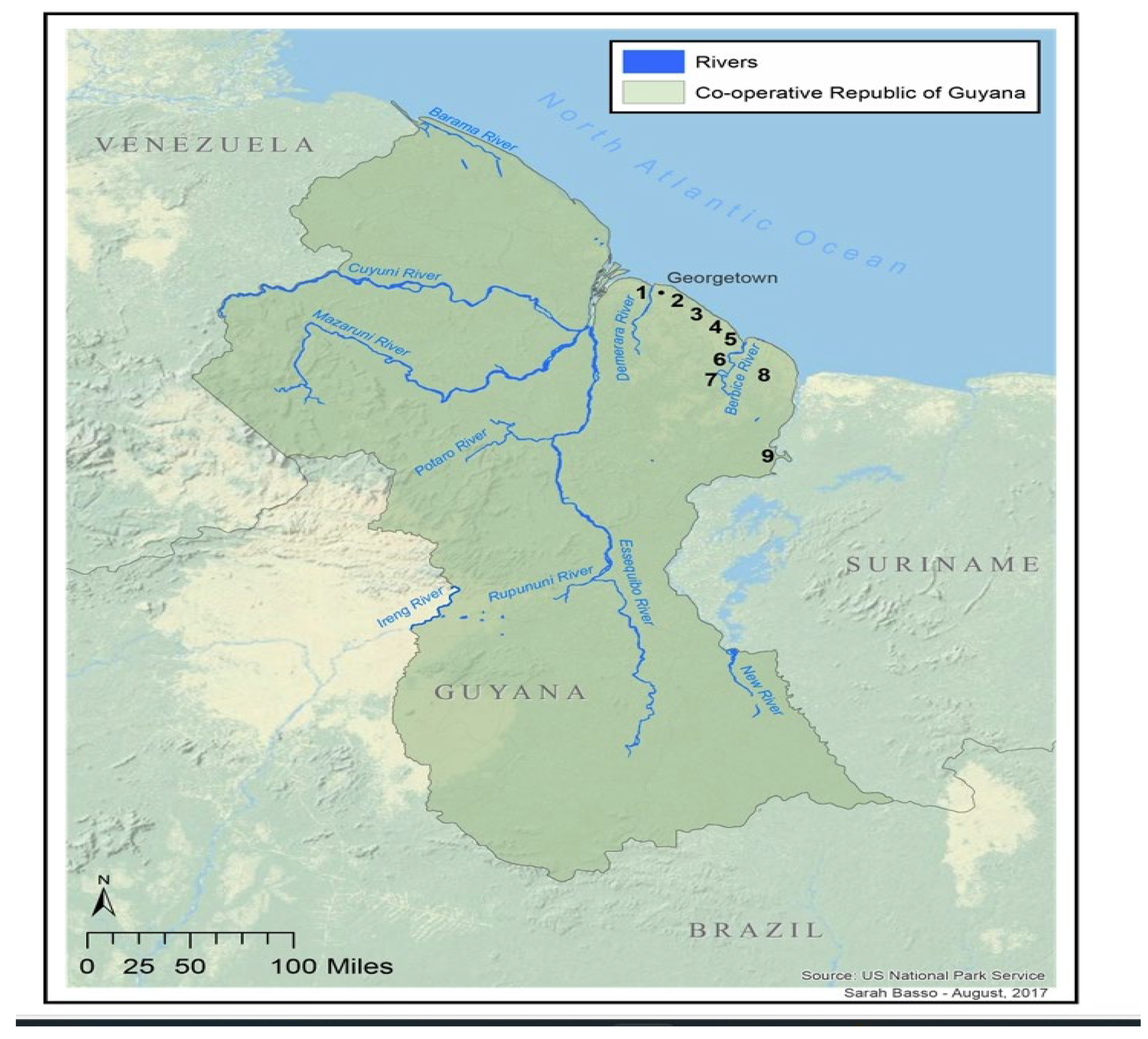
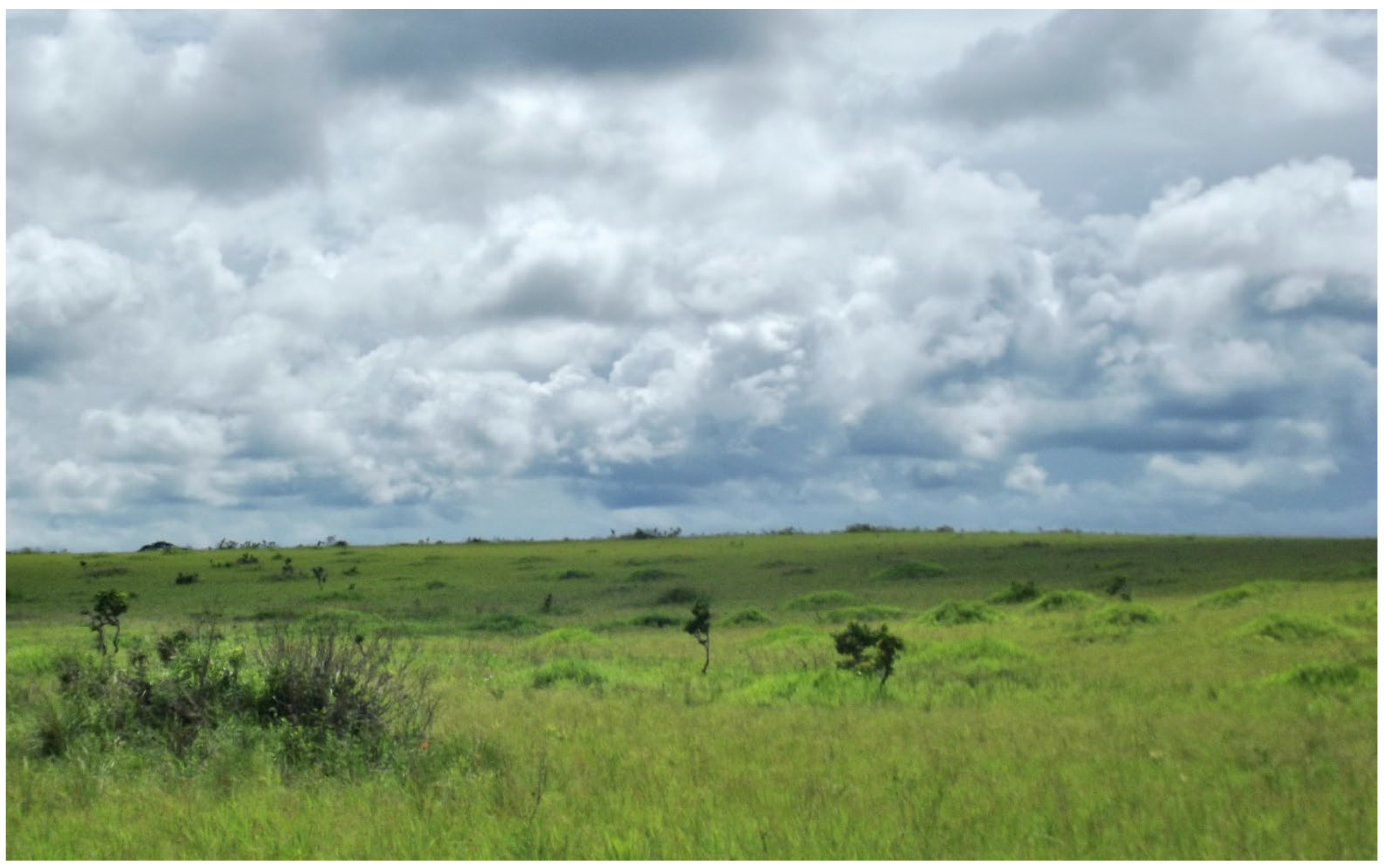
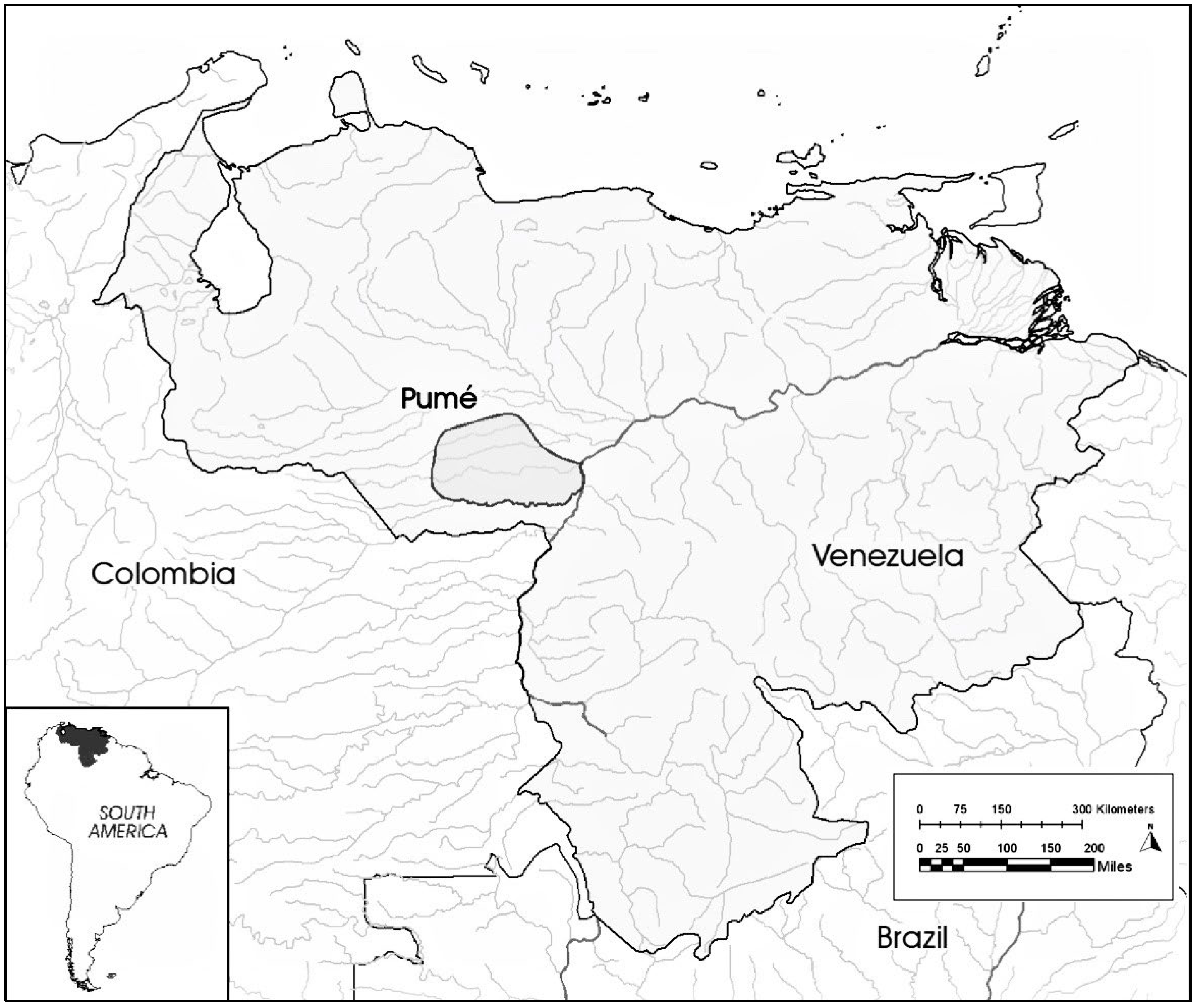
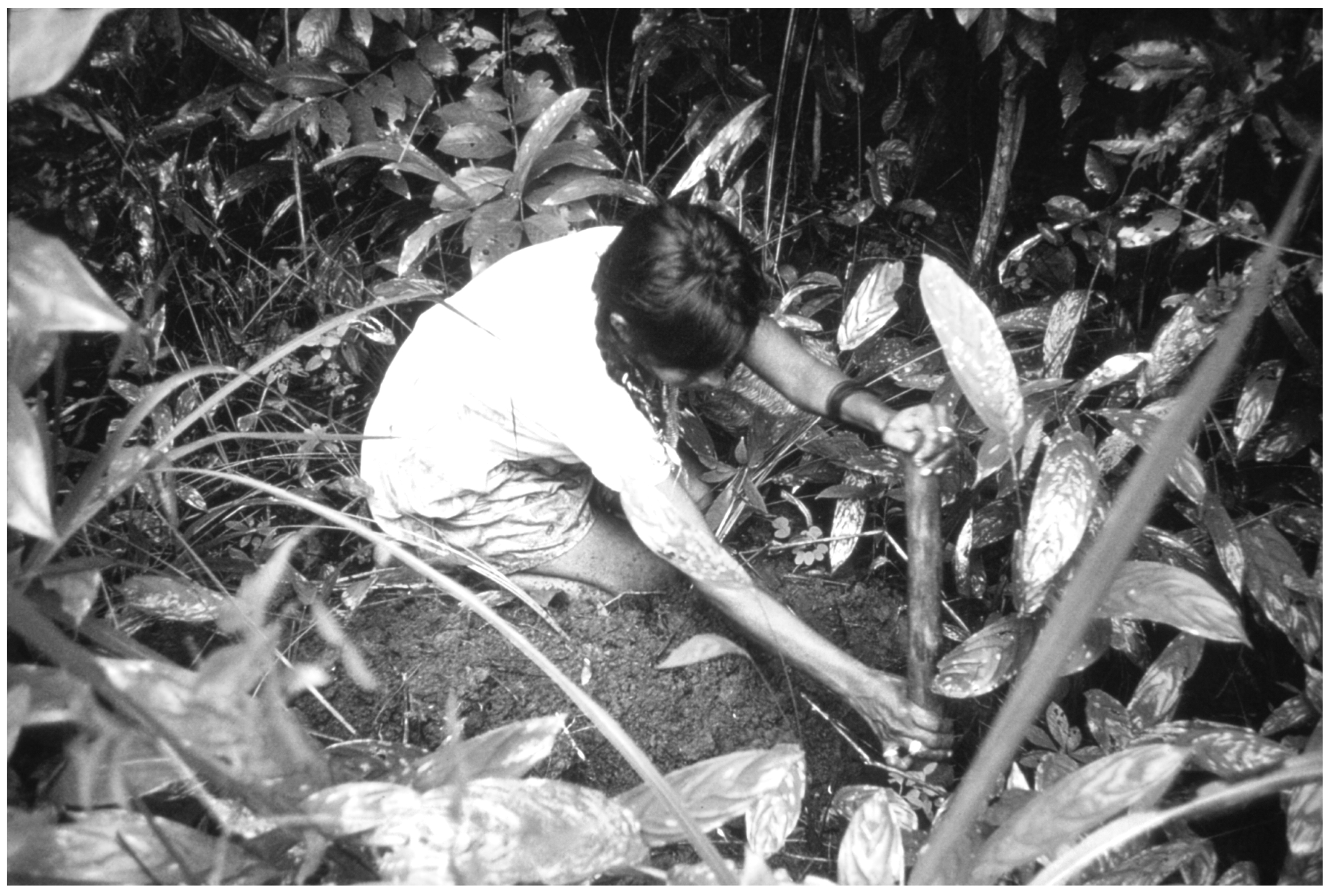

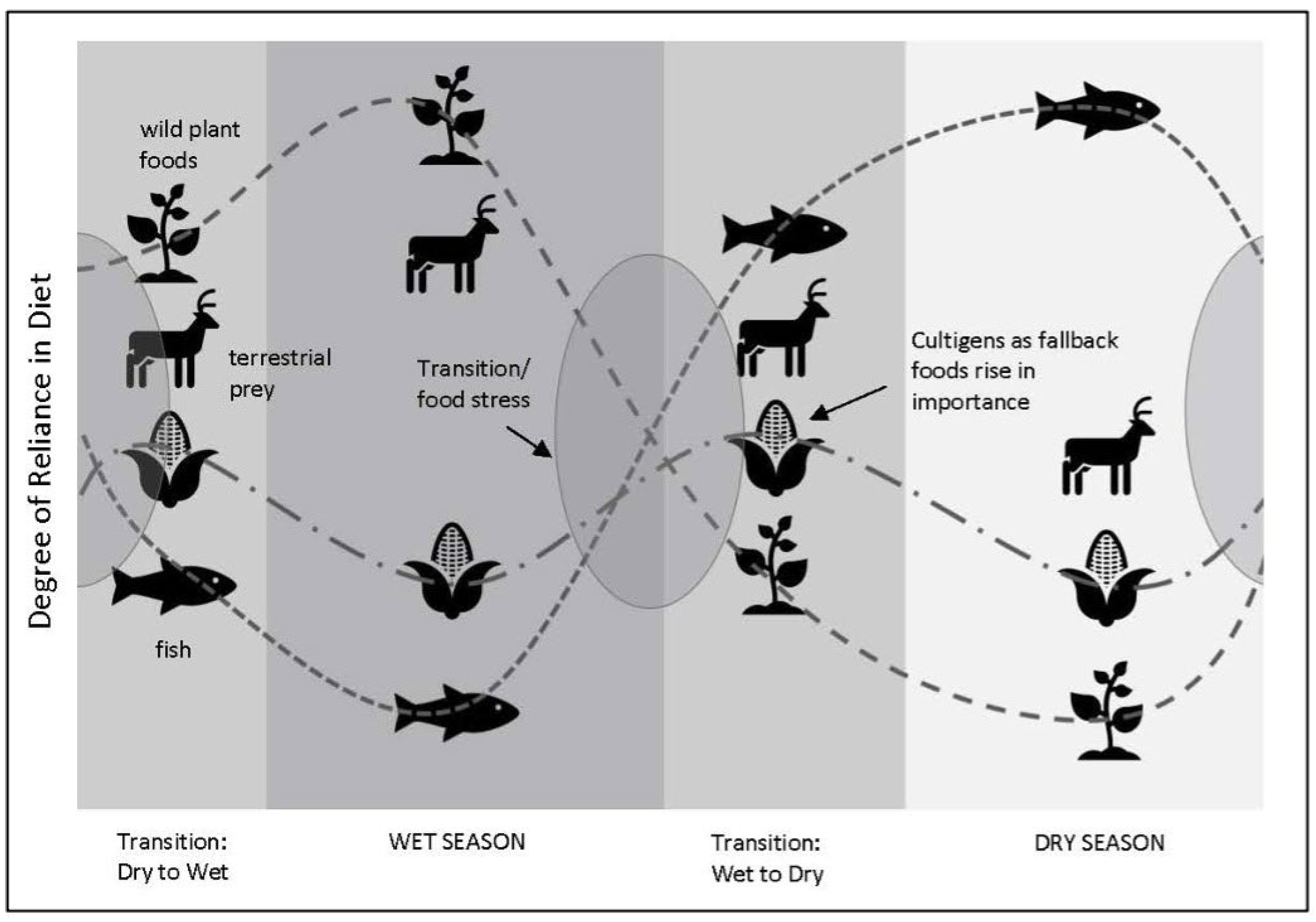
| Cultural Phenomenon | Várzea | Terra Firme |
|---|---|---|
| Predominant prey types | Fish, shellfish, turtles, other aquatic species | Broad spectrum: small-bodied terrestrial prey, some aquatic |
| Population distribution/density | Rapid increases; densely occupied by c. 1000 BP * | Increases delayed; more dispersed and scantier than várzea |
| Mobility pattern | Focused on river floodplain; semi-sedentary then mostly sedentary | Frequent mobility followed by long-term semi-sedentism |
| Emergence of societal complexity | c. 4000 BP to 1000 BP; chiefdom level inferred by c. 1000 BP | Delayed till c. 1000–500 BP |
| Cultigen types | Arboriculture first and then tubers, followed by maize. Field agriculture before 1000 BP | Primarily tubers. Field agriculture develops late (c. 500 BP) |
| Ceramics and storage features | Earliest ceramics c. 8000 BP | Ceramics emerge c. 4000 BP |
| Earthworks | Earliest earthworks c. 1600 BP | ND |
Disclaimer/Publisher’s Note: The statements, opinions and data contained in all publications are solely those of the individual author(s) and contributor(s) and not of MDPI and/or the editor(s). MDPI and/or the editor(s) disclaim responsibility for any injury to people or property resulting from any ideas, methods, instructions or products referred to in the content. |
© 2025 by the authors. Licensee MDPI, Basel, Switzerland. This article is an open access article distributed under the terms and conditions of the Creative Commons Attribution (CC BY) license (https://creativecommons.org/licenses/by/4.0/).
Share and Cite
Plew, M.G.; Yu, P.-L. Perspectives on Early Amazonian Agriculture from Guyana and Venezuela. Quaternary 2025, 8, 34. https://doi.org/10.3390/quat8030034
Plew MG, Yu P-L. Perspectives on Early Amazonian Agriculture from Guyana and Venezuela. Quaternary. 2025; 8(3):34. https://doi.org/10.3390/quat8030034
Chicago/Turabian StylePlew, Mark G., and Pei-Lin Yu. 2025. "Perspectives on Early Amazonian Agriculture from Guyana and Venezuela" Quaternary 8, no. 3: 34. https://doi.org/10.3390/quat8030034
APA StylePlew, M. G., & Yu, P.-L. (2025). Perspectives on Early Amazonian Agriculture from Guyana and Venezuela. Quaternary, 8(3), 34. https://doi.org/10.3390/quat8030034







